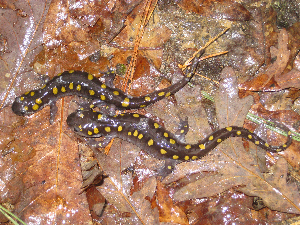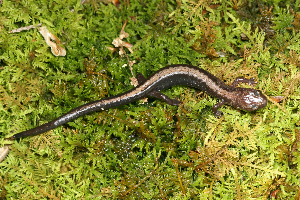Search ARMI Database
Search term(s)
Contribution Number
Search Results
35 record(s) found.
Data Release Amphibian nighttime call data from Midwest ARMI cricket frog surveys 2024
Authors: Mark F Roth; Aubrey A Schwonek; Jason Tendler; Ryan C Burner
Date: 2025-05-13 | Outlet: U.S. Geological Survey data release
Amphibian nighttime call data from Midwest ARMI surveys conducted in 2024 in Minnesota, Wisconsin, Iowa, Illinois. Many of the surveys were targeting potential Blanchard's cricket frog (Acris blanchardi) habitat.
Data Release Amphibian nighttime call data from Midwest ARMI surveys 2003-2008
Authors: Mark F Roth; Ryan C Burner; Walt J Sadinski
Date: 2025-05-13 | Outlet: U.S. Geological Survey data release
Amphibian nighttime call data from Midwest ARMI surveys conducted in 2003-2008 in Minnesota, Wisconsin, Iowa, Illinois. Many of the surveys were targeting potential Blanchard's cricket frog (Acris blanchardi) habitat
Data Release Mercury concentrations in amphibian tissues across the United States, 2016-2021
Authors: Colleen S Emery; Collin A Eagles-Smith; Kelly L Smalling; Blake R Hossack; Brian J Tornabene; Michael J Adams; Adam R Backlin; Adrianne B Brand; Robert N Fisher; Jill Fleming; Brad M Glorioso; Daniel A Grear; Evan HC Grant; Brian J Halstead; Patrick M Kleeman; David AW Miller; Erin Muths; Christopher A Pearl; Jennifer C Rowe; Caitlin T Rumrill; Hardin J Waddle; Megan E Winzeler
Date: 2023-08-23
Comma-separated values (.csv) file containing data related to amphibian sampling across the United States between 2016 and 2021. Data files contain mercury concentrations in amphibian and dragonfly tissues, mercury concentrations in sediment, as well as amphibian morphometrics, and habitat and climate characteristics where the samples were collected.
Data Release Data from an annual trapping effort of an urban aquatic turtle population in Lafayette, Louisiana from 2009–2021
Authors: Brad M Glorioso
Date: 2022-09-27
Data Release Long-term effects of timber harvest on vernal pool availability and occupancy of two obligate amphibians: U.S. Geological Survey data release
Authors: Evan HC Grant; Adrianne B Brand
Date: 2023-05-23 | Outlet: ScienceBase
This data set is comprised of 3 files of information collected on amphibians and vernal pool habitats at Canaan Valley National Wildlife Refuge from 2004 - 2016.
Data Release Data release - Abiotic and biotic factors reduce viability of a high-elevation salamander in its native range
Authors: Evan HC Grant; Graziella V DiRenzo; Adrianne B Brand
Date: 2023-04-11 | Outlet: ScienceBase
Includes data used to estimate population demographic parameters for an exemplary high-elevation amphibian species, the federally endangered Shenandoah salamander (Plethodon shenandoah). These parameters were entered into a Markov projection model which we used to forecast the future population status of the Shenandoah salamander.
Data Release Capture-mark-recapture data for Oregon spotted frogs [Rana pretiosa] along the Deschutes River, Oregon, 2016-2019
Authors: Jennifer C Rowe; Adam Duarte; Christopher A Pearl; Brome McCreary; P K Haggerty; Michael J Adams
Date: 2021-06-04 | Outlet: Ecosphere, v. 12, no. 6, p. e03634
Altered flow regimes can contribute to dissociation between life history strategies and environmental conditions, leading to reduced persistence reported for many wildlife populations inhabiting regulated rivers. The Oregon spotted frog Rana pretiosa is a threatened species occurring in floodplains, ponds, and wetlands in the Pacific Northwest with a core range in Oregon, USA. All life stages of R. pretiosa are reliant on aquatic habitats, and inundation patterns across the phenological timeline can have implications for population success. We conducted capture–mark–recapture (CMR) sampling of adult and subadult R. pretiosa at three sites along the Deschutes River downstream from two dams that regulate flows. We related the seasonal extent of inundated habitat at each site to monthly survival probabilities using a robust design CMR model. We also developed matrix projection models to simulate population dynamics into the future under current river flows. Monthly survival was strongly associated with the extent and variability of inundated habitat, suggesting some within-season fluctuations at higher water levels could be beneficial. Seasonal survival was lowest in the winter for all three sites, owing to limited water availability and the greater number of months within this season relative to other seasons. Population growth for the two river-connected sites was most strongly linked to adult survival, whereas population growth at the river-disconnected site was most strongly tied to survival in juvenile stages. This research identifies population effects of seasonally limited water and highlights conservation potential of enhancing survival of particularly influential life stages.
Data Release Report to NECSC: Adaptive capacity in a forest indicator species
Authors: Evan HC Grant; David AW Miller; David J Muñoz; S C Sterrett; Adrianne B Brand; T D Dubreiul; M O'Donnell; R Schilder
Outlet: ScienceBase
Data contain metabolic rates of red-backed salamanders (Plethodon cinereus) exposed to different thermal regimes, and the movements of salamanders marked with PIT tags and exposed to electromagnetic fields.
Data Release Data from a road ecology study of Spotted Salamanders along the Natchez Trace Parkway, Mississippi, in 2012-2013
Authors: Brad M Glorioso; Hardin J Waddle
Date: 2025-03-25 | Outlet: ScienceBase
This dataset contains study results examining the effect of road mortality on migrating salamanders along the Natchez Trace Parkway in Mississippi from 2012-2013. A combination of methods were used to assess the movement of salamanders to and from the breeding pond. Environmental variables such as air and water temperature, water salinity, and relative humidity were also collected during the study. A traffic counting device was also installed at the edge of the study area to monitor the number of vehicles passing through the area during migration events. Surveys to quantify egg masses in the breeding pond were also completed during the study.
Data Release Data from a turtle trapping effort targeting alligator snapping turtles (Macrochelys temminckii) in the Atchafalaya Basin beginning in 2019
Authors: Brad M Glorioso; Hardin J Waddle
Date: 2021-10-25 | Outlet: ScienceBase
This dataset contains data from an ongoing trapping effort beginning in 2019 targeting alligator snapping turtles (Macrochelys temminckii) in the Atchafalaya Basin of south-central Louisiana.
Data Release Data from a 2019 occupancy survey of alligator snapping turtles, Macrochelys temminckii, in south-central Louisiana
Authors: Brad M Glorioso; Hardin J Waddle
Date: 2021-09-14 | Outlet: ScienceBase
This dataset contains data on trapping methodology, turtle captures, and environmental variables from a trapping effort targeting alligator snapping turtles (Macrochelys temminckii) in south-central Louisiana in 2019.
Data Release Amphibian Occupancy and Effects of Habitat Use on Pesticide Exposure in Iowa Wetlands
Authors: Don Dennerline
Outlet: USGS
Data used in manuscript applying occupancy analysis to estimate presence of four anuran species at wetlands in northern Iowa as a function of eight environmental
covariates hypothesized to affect occupancy.
covariates hypothesized to affect occupancy.
Data Release Survival and sublethal effects of amphibians exposed to NaCl and brines from energy production
Authors: Brian J Tornabene; Creagh W Breuner; Blake R Hossack
Date: 2019-06-25 | Outlet: PANGAEA Data Publisher for Earth & Environmental Science
We investigated the influence of brines and NaCl alone at commensurate concentrations on three larval amphibian species that occur in areas with energy-related brine contamination. The dataset contains size information (mass in grams, snout-vent length in millimeters) of larval Boreal Chorus Frogs (Pseudacris maculata) and Leopard Frogs (Rana pipiens) and Barred Tiger Salamanders (Ambystoma mavortium) taken during 96-h lethal-concentration-50 experiments. Larvae were generally exposed to concentrations of brine or NaCl ranging from 0–8,000 mg/L increasing by 1,000 mg/L increments. Other associated dataset: https://doi.pangaea.de/10.1594/PANGAEA.913836
Data Release Corticosterone Mediates Lethal and Sublethal Effects and a Growth-Survival Tradeoff for a Larval Amphibian Exposed to Increased Salinity
Authors: Brian J Tornabene; Blake R Hossack; E J Crespi; Creagh W Breuner
Date: 2018-11-06 | Outlet: PANGAEA Data Publisher for Earth & Environmental Science
We investigated the influence of increased salinity on survival, growth, water content, and Corticosterone responses of larval Northern Leopard Frogs (Rana pipiens) by exposing them to environmentally-relevant salinity treatments for 24 days. We also inhibited Corticosterone for half of the replicates using mifepristone to determine if Corticosterone mediates effects of salinity and tradeoffs between traits. Other associated datasets:
https://doi.pangaea.de/10.1594/PANGAEA.919212
https://doi.pangaea.de/10.1594/PANGAEA.919211
https://doi.pangaea.de/10.1594/PANGAEA.919209
https://doi.pangaea.de/10.1594/PANGAEA.919212
https://doi.pangaea.de/10.1594/PANGAEA.919211
https://doi.pangaea.de/10.1594/PANGAEA.919209
Data Release Hatching success, survival, size and development, and behavioral data for two amphibian species exposed to NaCl and energy-related saline wastewaters
Authors: Brian J Tornabene; Creagh W Breuner; Blake R Hossack
Date: 2021-09-24 | Outlet: figshare
We investigated the relative effects of NaCl and energy-related saline wastewaters on hatching success, survival, size and development, and behaviors of northern leopard frogs ([i]Rana pipiens[/i]) and boreal chorus frogs ([i]Pseudacris maculata[/i]). Eggs were exposed and responses were tracked through hatching for 24 days. Five datasets are included. (1) Includes hatching and survival data for leopard frog eggs and larvae. (2) Includes hatching and survival data for chorus frog eggs and larvae. (3) Includes behavioral responses of both species monitored daily from day 9–24. (4) Includes morphology measurements from larval leopard frogs taken at the end of the experiment on day 24. (5) Includes morphology measurements from larval leopard frogs taken at the end of the experiment on day 24.
Data Release Aldosterone and corticosterone of a larval amphibian exposed to increased salinity
Authors: Brian J Tornabene; Creagh W Breuner; Blake R Hossack; E J Crespi
Date: 2021-09-29 | Outlet: figshare
We exposed larval leopard frogs to increased salinity and RU486 (a glucocorticoid receptor antagonist) and tested their influence on waterborne corticosterone (baseline and stress-induced) and aldosterone and relationships between the two adrenal steroid hormones.
Data Release Field data to support speciation with gene flow in a narrow endemic West Virginia cave salamander (Gyrinophilus subterraneus)
Authors: Evan HC Grant; Adrianne B Brand
This data set is comprised of 2 files consisting of field observations, morphological measurements, and water quality measurements relevant to a publication on the classification and population status of the WV Spring salamander, Gyrinophilius subterraneus.
Data Release California Red-Legged Frogs in Point Reyes coastal dune drainages (2015)
Authors: Brian J Halstead; Patrick M Kleeman
Date: 2017-05-22 | Outlet: USGS - Science Base
California Red-legged Frogs (Rana draytonii) are typically regarded as inhabitants of permanent ponds, marshes, and slow-moving streams, but their ecology in other habitats, including coastal dunes, remains obscure. To avoid and minimize potential negative effects of dune restoration activities, we studied the spatial ecology, habitat selection, and survival of California Red-legged Frogs in coastal dune drainages at Point Reyes National Seashore, California. Frogs remained in their home drainages throughout the summer, and, with some notable exceptions, most remained close to water. Home ranges of California Red-legged Frogs in dunes were generally small, and they selected areas near water with logs that served as refuge from environmental extremes and predators. California Red-legged Frogs avoided invasive dune plants, and had high survival rates in coastal dune drainages. Whether frogs will use dunes dominated by native species in the same manner as they use dunes degraded by non-native plants, and whether a more dynamic dune ecosystem will maintain the microhabitats necessary to support California Red-legged Frog populations in the future remains unknown.
Data Release Data realease for manuscript: A statistical forecasting approach to metapopulation viability analysis
Authors: P E Howell; Blake R Hossack; Erin Muths; Brent H Sigafus; A Chenevert-Steffler; Richard Chandler
Date: 2020 | Outlet: Ecological Applications 2020: e02038
Data release and code for Ecological Applications paper: A statistical forecasting approach to metapopulation viability analysis
Data Release Data from time-constrained visual encounter surveys and acoustic surveys in the Atchafalaya Basin conducted from 2008 through 2016
Authors: Brad M Glorioso; Hardin J Waddle
Date: 2020-08-13
This dataset contains data from time-constrained visual encounter surveys conducted in the Atchafalaya River Basin in south central Louisiana from February 2008 through July 2016. In addition, it contains vocalization data collected concurrently with the visual encounter surveys and data on presence of tadpoles and larvae. All participants in surveys are included in the dataset. Information for each site, each sample, and each observation is included.



